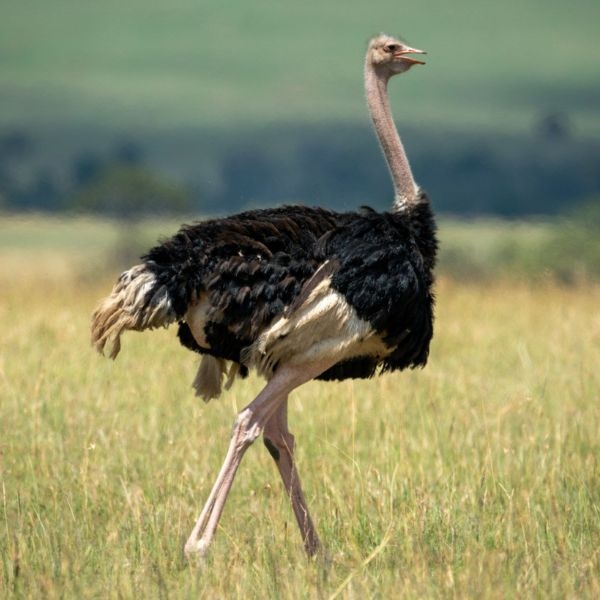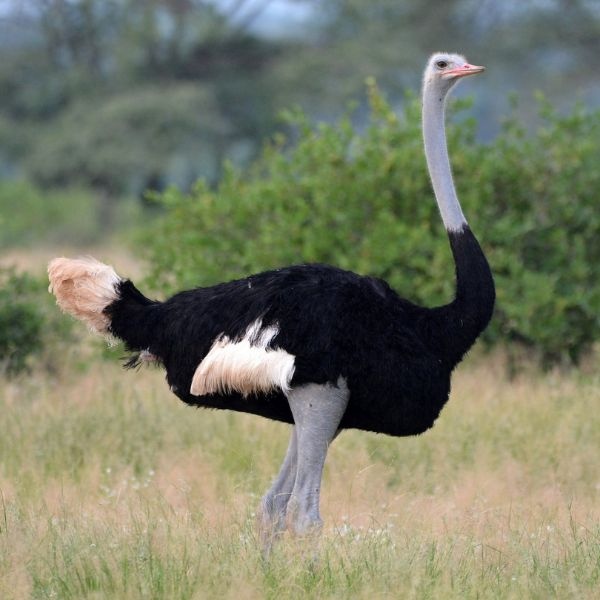Encountering birds in our daily lives often showcases their petite stature, with many weighing just a few grams. Astonishingly, certain avian species defy this conventional size, achieving heights that surpass even those of the tallest humans.
The largest birds on our planet, predominantly flightless, possess denser bones and more substantial bodies. Their evolutionary adaptations go beyond mere size, encompassing robust leg muscles that empower them to sprint at remarkable speeds, a crucial skill in evading predators.

Common Ostrich
Nevertheless, none of the present avian giants come close to the colossal statue of the extinct elephant birds, belonging to a bygone family of ratites. The most monumental among them, the Vorombe titan, exceeded 700 kg in weight and stood at approximately 3 m, securing the title of the largest bird to ever inhabit the Earth. This compilation, therefore, delves into the roster of the ten most massive extant birds globally.
ALSO READ| List of 11 Critically Endangered Species of Birds in India
Top 10 Largest Birds in the World
Topping the list as the most massive extant bird species is the common ostrich (Struthio camelus), closely pursued by the Somali ostrich (Struthio Molybdophanes). A male ostrich can attain an impressive height of 2.8 meters (9.2 feet) and carry a staggering weight exceeding 156.8 kg (346 lb). Although a mass of 200 kg (440 lb) has been attributed to the ostrich, no wild specimens of this weight have been substantiated.
Even the distinction of harbouring the largest eggs among all bird species belongs to the ostrich, with their eggs averaging an impressive 1.4 kg (3.1 lb). Here is a complete list of the 10 biggest birds in the world:
| Rank | Common name | Binomial Name | Average mass | Maximum Mass | Average Length | Flighted |
| 1 | Common Ostrich | Struthio Camelus | 104 kg (229 lb) | 156.8 kg (346 lb) | 210 cm (6.9 ft) | No |
| 2 | Somali Ostrich | Struthio Molybdophanes | 90 kg (200 lb) | 130 kg (290 lb) | 200 cm (6.6 ft) | No |
| 3 | Southern Cassowary | Casuarius Casuarius | 45 kg (99 lb) | 85 kg (187 lb) | 155 cm (5.09 ft) | No |
| 4 | Northern Cassowary | C. Unappendiculatus | 44 kg (97 lb) | 75 kg (165 lb) | 149 cm (4.89 ft) | No |
| 5 | Emu | Dromaius Novaehollandiae | 33 kg (73 lb) | 70 kg (150 lb) | 153 cm (5.02 ft) | No |
| 6 | Emperor Penguin | Aptenodytes Forsteri | 31.5 kg (69 lb) | 46 kg (101 lb) | 114 cm (3.74 ft) | No |
| 7 | Greater Rhea | Rhea Americana | 23 kg (51 lb) | 40 kg (88 lb) | 134 cm (4.40 ft) | No |
| 8 | Dwarf Cassowary | Casuarius Bennetti | 19.7 kg (43 lb) | 34 kg (75 lb) | 105 cm (3.44 ft) | No |
| 9 | Lesser Rhea | Rhea pennata | 19.6 kg (43 lb) | 28.6 kg (63 lb) | 96 cm (3.15 ft) | No |
| 10 | King Penguin | Aptenodytes patagonicus | 13.6 kg (30 lb) | 20 kg (44 lb) | 92 cm (3.02 ft) | No |
Struthio Camelus Vs Struthio Molybdophanes
The ostrich, scientifically known as Struthio camelus, commonly referred to as ostrich, inhabits expansive regions of Africa, characterised by its flightless nature. Within the ratite order of birds, it stands as one of two existing ostrich species, representing the sole living members of the Struthio genus. The second species, Struthio Molybdophanes, previously regarded as a distinct subspecies, gained recognition as a separate species by BirdLife International in 2014.
Anton Reichenow's description of Struthio Molybdophanes in the Norddeutsche Allgemeine Zeitung Sunday Supplement of 16 September 1883 outlined its habitat across the plains of Somali- and western Galla-Land along the eastern African coast, spanning from 10 degrees north to the Equator.

Somali Ostrich
Different from other ostriches, the Somali ostrich exhibits blue skin on its neck and thighs, intensifying to a vibrant blue hue in males during mating. Distinguishing characteristics include the absence of the typical broad white ring around the neck and white tail feathers. Male Somali ostriches surpass females in size, maintaining a comparable scale to other ostrich species, albeit potentially marginally smaller than certain subspecies of the common ostrich, specifically the nominate race, S. c. camelus. While captive Somali ostriches reportedly weigh around 105 kg (231 lb), this measurement might not accurately reflect the weight of wild birds, given the different feeding resources available in captivity versus the wild. Consequently, it ranks among the two largest existing bird species
Comments
All Comments (0)
Join the conversation